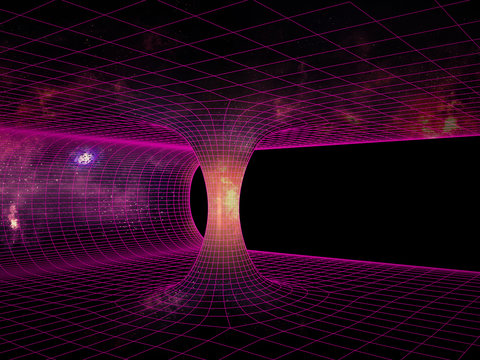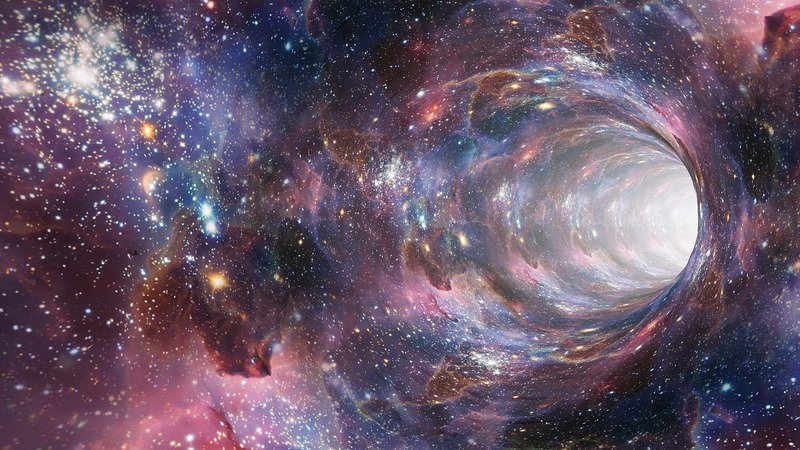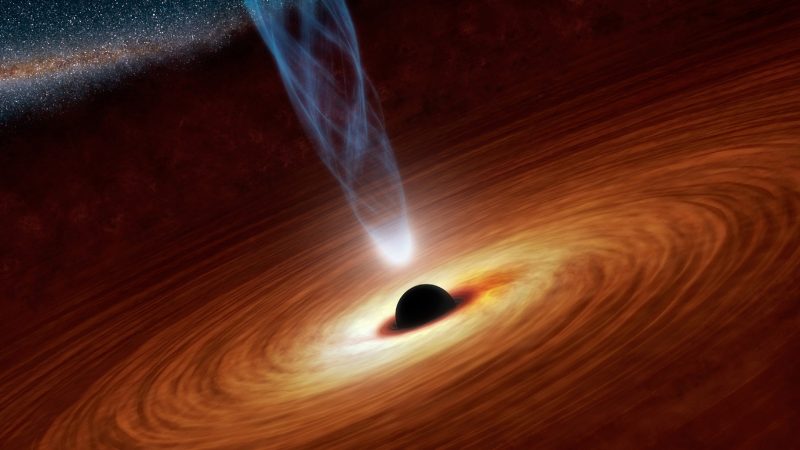Read carefully What is Wormhole? Wormholes Explained. If you saw a wormhole in reality, it would appear round, spherical, a bit like a black hole. Light from the other side passes through and gives you a window to a faraway place.
Once crossed, the other side comes fully into view with your old home now receding into that shimmering spherical window. But are wormholes real, or are they just magic disguised as physics and maths? If they are real, how do they work and where can we find them?
For most of human history, we thought space was pretty simple; a big flat stage where the events of the universe unfold. Even if you take down the set of planets and stars, there’s still something left. That empty stage is space and it exists, unchanging and eternal. Einstein’s theory of relativity changed that. It says that space and time make up that stage together, and they aren’t the same everywhere.
The things on the stage can affect the stage itself, stretching and warping it. If the old stage was like unmoving hardwood, Einstein’s stage is more like a waterbed. This kind of elastic space can be bent and maybe even torn and patched together, which could make wormholes possible. Let’s see what that would look like in 2D.
Our universe is like a big flat sheet, bent in just the right way, wormholes could connect two very, very distant spots with a short bridge that you could cross almost instantaneously. Enabling you to travel the universe even faster than the speed of light. So, where can we find a wormhole? Presently, only on paper.
General relativity says they might be possible, but that doesn’t mean they have to exist. General relativity is a mathematical theory. It’s a set of equations that have many possible answers, but not all maths describes reality. But they are theoretically possible and there are different kinds. EINSTEIN ROSEN BRIDGES The first kind of wormholes to be theorized were Einstein Rosen Bridges.
They describe every black hole as a sort of portal to an infinite parallel universe. Let’s try to picture them in 2D again. Empty space-time is flat, but curved by objects on it. If we compress that object, space-time gets more curved around it. Eventually, space-time becomes so warped that it has no choice but to collapse into a black hole.
A one-way barrier forms: the event horizon, which anything can enter but nothing can escape; trapped forever at the singularity at its core. But maybe there is no singularity here. One possibility is that the other side of the event horizon looks a bit like our universe again but mirrored upside down, where time runs backward. In our universe things fall into the black hole. In the parallel universe, with backward time, the mirror black hole is spewing things out a bit like a big bang.
This is called a white hole. Unfortunately, Einstein-Rosen bridges can’t actually be crossed. It takes an infinite amount of time to cross over to the opposite universe and they crimp shut in the middle.
If you go into a black hole, you won’t become the stuff coming out of the white hole. You’ll only become dead. So, to travel the cosmos in the blink of an eye, humans need a different kind of wormhole; a Traversable Wormhole.
VERY OLD STRING THEORY WORMHOLES. If string theory or one of its variations is the correct description of our universe, then we could be lucky and our universe might even have a tangled web of countless wormholes already. Shortly after the Big Bang, Quantum fluctuations in the universe at the smallest scales far smaller than an atom may have created many, many traversable wormholes. Threaded through them are strings, called cosmic strings.
In the first billionth of a trillionth of a second after the Big Bang, the ends of these tiny, tiny wormholes were pulled light-years apart; scattering them through the universe. If wormholes were made in the early universe, whether with cosmic strings or some other way, they could be all over; just waiting to be discovered.
One might even be closer than we realize. From the outside, black holes and wormholes can look very similar; leading some physicists to suggest the supermassive black holes in the center of galaxies are actually wormholes. It will be very hard to go all the way to the center of the Milky Way to find out though, but that’s okay.
There might be an equally extremely hard way to get our hands on a wormhole, we could try to make one. MANMADE WORMHOLES To be traversable and useful, there are a few properties we want a wormhole to have. First, it must obviously connect to distant parts of space-time.
Like your bedroom and the bathroom, or Earth and Jupiter. Second, it should not contain any event horizons, which would block two-way travel. Third, it should be sufficiently sized so that the gravitational forces don’t kill human travelers.
The biggest problem we have to solve is keeping our wormholes open. No matter how we make wormholes, gravity tries to close them. Gravity wants to pinch it closed and cut the bridge; leaving only black holes at the ends.
Whether it’s a traversable wormhole with both ends in ours or a wormhole to another universe, it will try to close unless we have something propping it open. For very old string theory wormholes, that’s the cosmic strings job. For man-made wormholes, We need a new ingredient.
Exotic matter. This isn’t anything like we find on earth, or even antimatter. It’s something totally new and different and exciting, with crazy properties like nothing that’s ever been seen before. Exotic matter is stuff that has a negative mass. Positive mass like people and planets and everything else in the universe is attractive because of gravity. But negative mass would be repulsive; it would push you away.
This makes a kind of anti-gravity the props open our wormholes. And exotic matter must exert enormous pressure to push space-time open, greater even than the pressure of the centers of neutron stars. With exotic matter, we could weave space-time however we see fit. We may even have a candidate for this exotic matter, the vacuum of space itself.
Quantum fluctuations in empty space are constantly creating pairs of particles and antiparticles, only for them to be annihilated an instant later. The vacuum of space is boiling with them, and we can already manipulate them to produce an effect similar to the negative mass we’re looking for.
We could use this to stabilize our wormholes. Once we’re keeping it open, the ends would start together. So, we’d have to move them around to interesting places. We could start by wiring the solar system; leaving one end of each wormhole in orbit around the Earth.
We could flick others into deep space. The earth could be a wormhole hub for a vast interstellar human civilization spread over light-years, but only a wormhole away. However, wormholes have a dark side. Even opening a single wormhole, kind of breaks the universe in fundamental ways, potentially creating time travel paradoxes, and violating the causal structure of the universe.
Many scientists think that this not only means they should be impossible to make but that it’s impossible for them to exist at all. So, for now, we only know that wormholes exist in our hearts, and on paper in the form of equations. We know you want to know more about universe stuff, so, we’re trying something new.
I hope you guys find the answer to the what is wormhole in space and What is Wormhole. Thank you for Reading our article. Don’t forget to click the like on our Facebook, Twitter, Instagram and Pinterest. Your support means a lot to us. All social media links are found on the very down of this page.
I hope you like our article about Wormholes Explained.
Feel free to comment more down below your idea and don’t hesitate to share or pin our article…
You Might Like-
Visit Our Online Shop Website- WWW.CEYLEBRITY.COM
Ceylebrity Sinhala News And Articles- WWW.CEYLEBRITYNEWS.LK
Knowledge World Blog- WWW.KNOWLEDGEWORLD.BLOG
Share








Greetings, explorers of unique punchlines !
100 funny jokes for adults by topic – http://jokesforadults.guru/ dad jokes for adults
May you enjoy incredible surprising gags!
¡Saludos, aventureros de experiencias intensas !
Casino regalo bienvenida con registro – http://bono.sindepositoespana.guru/ casino con bonos de bienvenida
¡Que disfrutes de asombrosas premios excepcionales !
¡Saludos, participantes de juegos emocionantes !
Casino sin registro sin compartir documentos – http://www.emausong.es/ emausong.es
¡Que disfrutes de increíbles jugadas impresionantes !
¡Hola, participantes de desafíos emocionantes !
Casino sin licencia con mГ©todos de pago anГіnimos – п»їcasinosonlinesinlicencia.es casino sin licencia espaГ±ola
¡Que vivas increíbles victorias memorables !
¡Saludos, participantes de retos !
Casino sin licencia en EspaГ±ola funcional – http://audio-factory.es/ casinos sin licencia espaГ±a
¡Que disfrutes de asombrosas movidas excepcionales !
¡Hola, cazadores de tesoros ocultos !
Casino online sin licencia EspaГ±a con soporte en espaГ±ol – https://casinosinlicenciaespana.xyz/# casino sin licencia en espaГ±a
¡Que vivas increíbles instantes únicos !
¡Saludos, apostadores habilidosos !
Casino online extranjero: juega sin lГmites desde casa – https://www.casinoextranjerosdeespana.es/# casino online extranjero
¡Que experimentes maravillosas premios excepcionales !
Can you be more specific about the content of your article? After reading it, I still have some doubts. Hope you can help me.
¡Saludos, aventureros del destino !
casino fuera de EspaГ±a ideal para high rollers – https://www.casinosonlinefueraespanol.xyz/ casinos online fuera de espaГ±a
¡Que disfrutes de instantes inolvidables !
¡Hola, jugadores expertos !
Mejores casinos extranjeros sin documentos – п»їhttps://casinosextranjerosdeespana.es/ mejores casinos online extranjeros
¡Que vivas increíbles recompensas extraordinarias !
¡Hola, exploradores del destino !
Casinos online extranjeros sin lГmites geogrГЎficos – п»їhttps://casinoextranjero.es/ casinoextranjero.es
¡Que vivas momentos únicos !
¡Saludos, jugadores dedicados !
ВїCuГЎl es el mejor casino online extranjero hoy? DescГєbrelo – https://www.casinoextranjerosenespana.es/# casinos extranjeros
¡Que disfrutes de giros espectaculares !
¡Saludos, expertos en el azar !
Disfruta en casinos extranjeros con bono gratis – https://www.casinosextranjero.es/ mejores casinos online extranjeros
¡Que vivas increíbles jackpots extraordinarios!
¡Hola, maestros del juego !
casinoonlinefueradeespanol con registro fГЎcil – https://www.casinoonlinefueradeespanol.xyz/# casino online fuera de espaГ±a
¡Que disfrutes de asombrosas tiradas afortunadas !
¡Saludos, participantes de emociones !
Mejores juegos en casinos online extranjeros 2025 – п»їhttps://casinosextranjerosenespana.es/ mejores casinos online extranjeros
¡Que vivas increíbles recompensas sorprendentes !
¡Hola, buscadores de fortuna !
Casinoextranjerosespana.es: lista de casinos sin documentos – https://casinoextranjerosespana.es/# casino online extranjero
¡Que disfrutes de asombrosas momentos memorables !
buy tiktok ad account https://tiktok-ads-agency-account.org
buy tiktok ads account https://buy-tiktok-ads.org
tiktok ads agency account https://buy-tiktok-business-account.org
tiktok ad accounts https://buy-tiktok-ads-accounts.org
tiktok ads account for sale https://buy-tiktok-ad-account.org
buy tiktok ads account https://tiktok-agency-account-for-sale.org
tiktok agency account for sale https://tiktok-ads-account-for-sale.org
tiktok ads agency account https://tiktok-ads-account-buy.org
buy tiktok business account https://buy-tiktok-ads-account.org
buy verified bm facebook https://buy-business-manager-accounts.org
buy verified facebook verified-business-manager-for-sale.org
buy facebook business manager buy-bm.org
buy verified bm facebook https://buy-business-manager-verified.org
buy business manager https://business-manager-for-sale.org/
buy facebook bm https://buy-verified-business-manager.org/
verified bm buy-verified-business-manager-account.org
facebook verified business manager for sale https://buy-bm-account.org
buy facebook ads accounts and business managers https://buy-business-manager-acc.org
old google ads account for sale https://buy-verified-ads-account.work
buy google adwords accounts https://ads-agency-account-buy.click
buy verified business manager https://buy-business-manager.org
buy google ads https://sell-ads-account.click
buy google adwords account https://buy-ads-agency-account.top
buy google ads accounts buy-account-ads.work
old google ads account for sale https://buy-ads-invoice-account.top
google ads reseller adwords account for sale
buy aged google ads accounts https://ads-account-for-sale.top
old google ads account for sale https://buy-ads-accounts.click
buy google ads invoice account https://buy-ads-account.top
buy accounts facebook https://ad-accounts-for-sale.work
facebook ads accounts https://buy-ad-account.click/
buy old facebook account for ads buy facebook profiles
buy aged fb account buying facebook accounts
buy facebook ad accounts https://ad-account-buy.top
facebook ads account buy cheap facebook account
buy facebook accounts buy accounts facebook
buy facebook profile https://buy-adsaccounts.work/
маркетплейс аккаунтов соцсетей https://kupit-akkaunt.online/
маркетплейс аккаунтов https://akkaunty-dlya-prodazhi.pro/
маркетплейс аккаунтов https://online-akkaunty-magazin.xyz/
продажа аккаунтов https://akkaunty-optom.live/
покупка аккаунтов kupit-akkaunty-market.xyz
продажа аккаунтов https://akkaunty-market.live
биржа аккаунтов магазины аккаунтов
маркетплейс аккаунтов kupit-akkaunt.xyz
купить аккаунт rynok-akkauntov.top
маркетплейс аккаунтов соцсетей https://akkaunty-na-prodazhu.pro/
account exchange accounts marketplace
account market https://buy-accounts.live/
account store https://social-accounts-marketplace.live
gaming account marketplace https://accounts-marketplace.art
account store https://buy-accounts-shop.pro
social media account marketplace https://buy-accounts.space
account selling service https://social-accounts-marketplace.xyz/
buy and sell accounts https://accounts-marketplace.live
secure account sales account market
accounts marketplace https://buy-best-accounts.org
account trading https://accounts-marketplace.xyz
accounts for sale https://accounts-offer.org
secure account purchasing platform account exchange
account exchange service account buying platform
secure account sales https://shop-social-accounts.org/
database of accounts for sale ready-made accounts for sale
account selling platform database of accounts for sale
marketplace for ready-made accounts accounts marketplace
purchase ready-made accounts account exchange service
accounts for sale database of accounts for sale
accounts market accounts for sale
account sale accounts market
account purchase best-social-accounts.org
account trading platform marketplace for ready-made accounts
sell pre-made account account purchase
account store account catalog
account selling service account purchase
online account store accounts market
website for selling accounts account exchange service
buy pre-made account account market
sell account ready-made accounts for sale
purchase ready-made accounts profitable account sales
account market online account store
sell pre-made account account buying platform
ready-made accounts for sale account exchange service
account sale buyaccountsdiscount.com
account marketplace account marketplace
account trading platform account trading platform
account selling service website for buying accounts
Ready-Made Accounts for Sale Buy and Sell Accounts
Accounts market Buy Account
Account trading platform Account exchange
Buy accounts Accounts marketplace
Account Buying Service Account Buying Service
Account Selling Platform Account Acquisition
Account Trading Service Database of Accounts for Sale
Account Trading Service Verified Accounts for Sale
Secure Account Purchasing Platform Account Buying Platform
Purchase Ready-Made Accounts Database of Accounts for Sale
Account Catalog Buy and Sell Accounts
аккаунт для рекламы гарантия при продаже аккаунтов
продажа аккаунтов безопасная сделка аккаунтов
заработок на аккаунтах купить аккаунт
маркетплейс аккаунтов профиль с подписчиками
безопасная сделка аккаунтов профиль с подписчиками
маркетплейс аккаунтов соцсетей купить аккаунт
купить аккаунт покупка аккаунтов